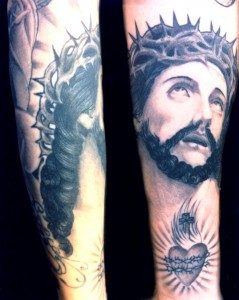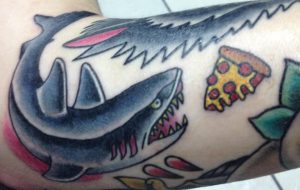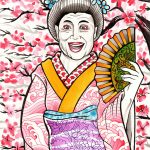Micah Harold, owner of Red Handed Tattoo, recently moved his shop to Kings Highway. He and fellow tattoo artist and mentor James Clements, along with John Bentrup, Joseph Pineda, and Ryan Whitmore, have lit up the corner of Kings and Highland with their impressive new shop, and are hard at work creating some of the area’s finest custom tattoos. We published what I found out about the new shop in our latest issue (with photos by Casey Habich). I recently caught up with Micah to investigate and our conversation took us in more directions than one story could hold, so we had to share the rest of the interview.
Basic background info. How long have you been tattooing?

Fifteen years. I only count the last seven though, because prior to that I was a flash artist. Which, you know around here, we’re talking 1999-2000, there was nowhere to go where we could learn what I do now, including using a stencil machine. Basically we’re talking traditional American tattoos and traditional Japanese tattoos. It took James Clements going to Corpus Christi and working with Chris Roberts for about seven years. He’s basically the Prometheus of tattoos for Shreveport-Bossier. He went out into the world, he learned what he had to learn, including using a stencil machine, and he brought it back and he taught two or three people here. That’s really how it works. You’ve heard me talk about tattoo schools before, where they’ll charge you 5 or 6 grand for two weeks. It’s shameful; it’s not what we do. [Tattooing is] master to apprentice and one day I’ll pass my torch to somebody and they’ll pass that torch and that’s the way it’s been done for thousands of years. So yeah, so far I’ve been studying traditional American tattoos and traditional Japanese tattoos for 7 years, including the use of a stencil machine. Anything prior to that I just kind of sweep under the rug, I try not to tell anybody. And in retrospect I don’t mind if anybody knows. It took me a long time to really understand the sacredness off tattoos. And now that I know, this is something that we can offer. James Clements and John Bentrup, Joseph Pineda and myself, we can offer that to Shreveport Bossier, where they didn’t have that before James came back from Corpus [Christi].
Yeah. I think I’ve got a few bootleg Micah Harold tattoos then.
(Laughs) I know, we got to do something about that.
Your style is very traditional, but everybody has his or her little tweak on it. The last tattoo you did on me has a hint of white, which is outside of traditional tattooing. How did you come about your style?
I was lucky because both my parents were artists. I was being reared as a fine artist before I was a tattooer. I curated my first art exhibit at the age of 17 at Turner Art Center under Bruce Allen. I was taught about all the greats, so my favorite painters where reissuance artists. Then we hit the 20th century and [I started] studying Paul Klee and Marcel Duchamp, and Picasso. Even Warhol, despite all his flaws, was significant in that. But what I found about fine art was that you didn’t have to earn it to be in it. A lot of it was privilege, a lot of it was high society, and a lot of it was who you knew. I didn’t appreciate that; I didn’t like it. Whereas with tattoos, it was a no dogs no master type deal. We were workers, middle class. We worked for what we got, we worked very hard to learn what we knew. And it wasn’t just about the art; it was about the technique, about the history. And here was something to where you really came into your own, on your own, through hard work and dedication; and the will to do it. I can’t describe you that sensation when you’re first laying a needle

on the skin and that realization of permanence hits you like a ton of bricks and some people freeze up. I’ve seen artist back out the minute they did their first tattoo. So that’s what really attracted me to the world of tattoos. You had to work for what you got; no one gave you anything. And if anything, if you were interested in doing tattoos, you show up, you try to figure it out and say “Hey, will you teach me how to do this? How can I get into the tattoo industry?” the common response was, “Give up. Get out of here.” I can speak for James and myself, failure wasn’t an option. It was either, we were going to do this, or we were going to be out in the street, with nowhere to go.
So, it was about 7 years ago that James came back and y’all started working together?
Yeah. He swooped me up mostly because I was able to lay down a clean tattoo. And that I attribute to doing so much flash. You know, pre-drawn stuff you see on the walls, people come in and say “I want that” boom boom boom; it’s that easy. But that flash did teach me how to run a clean line and how to lay down a clean tattoo; to where when James came along I just had to study the biology, the art, and the tradition of the tattoo. And that allowed me to become a strictly custom tattooer. And once you start pushing custom tattoos, you’ll never go back to flash. I saw the light. That’s when I fell in love with tattoos because prior to that I didn’t respect it; I didn’t understand it enough to respect it. Only when James showed me the beauty and the history and the etiquette, the technique and the reverence for tattoos, did I realize that I had wasted my life prior to that. It was all over from there. I was a tattooer.
Do you get that same gratification from doing a flash tattoo that you were talking about earlier?
Not at all, it’s just a job. It’s like a factory job. Where I was taught, the owner of the shop was more interested in getting them in and getting them out for the sake of profit. Which is, you know, it’s nice to make money, but a good tattoo is its own reward.
So when James came back, you helped him start his own shop, Fortune and Glory. How did that come about?
James came in town knowing exactly who he wanted to work with and exactly who he wanted to teach and I was lucky enough to be one of those guys. We just put our hearts into it, and we made it happen. And know we’ve got [the new Red Handed Tattoo shop]. We’re all together under this roof and we learn off of each other. That’s another thing that we have here that none of the other shops have. Where typically you may have like one guy [in a shop] that can lay down a clean tattoo, here we’re all beaming off of each other. That’s how we progress.
And we compete on a global level. We don’t look only at the local competition and say, “Oh, we’ve got to do better than them.” Forget that! We’re looking at guys in France, Russia, Sweden, and Japan.
And all these guys that you have with you here now are hand-picked right?
Oh yeah! Oh, yeah. Like Joseph, for example. His black and grey work is better than anybody else’s I’ve seen recently. I’m not trying to toot any horns about it, but I’m just saying he belongs here. It was a natural course for him to say, “You know what Micah, I really want to work with you and James,” and I said, “You know what Joseph, it’s funny you say that because I want to work with you, too. Let’s make this happen. Let’s put together the best crew that anybody has ever seen in Shreveport-Bossier.

There has been a big TV movement recently. We saw this massive jump in the culture of tattoos over the last even 5 to 10 years where tattoos used to be the mark of an outlaw and now they’re kind of a hipster rite of passage in some ways.
That’s right. It’s gone really commercial in some ways. And you’re right to associate it with outlaws because it’s even documented as far back as ancient Egypt where they tattooed criminals. The same thing happened in japan. That’s how you got all these beautiful, beautiful body suits that the Japanese started doing during the Edo period where the state would come in, if you were a criminal, whatever it was, they would tattoo the offense on you, so wherever you went everybody would know you were a criminal. Well, these guys had the good idea of taking all the art associated with wood-cutting, and using it to cover up the state issued tattoos. Which is why you have these super black backgrounds where everything – the wind, the water – is black, and these huge bright foregrounds, whether it’s like a deity or and animal. That was all designed to cover up state issued tattoos. Which is also why the Yakuza is associated with the Japanese body suit. So, in the early 90’s it started to shift to where people started wanting tattoos. By 2001- 2002, it was full-fledged. Everybody was getting them. But now a days, the tattoos belong to the working class, and that’s what I like about it. It’s a craft and tattooers are craftsmen.
But yeah, as far as, like, the commercialism – that’s both good and bad because you have all these TV shows and everyone’s an expert on it now. But I like that I can make a living doing tattoos. I love it. I’m very grateful. At the same time… you’ve got these guys doing it out of their house or anywhere they can, and it’s just not the way to go. The way to go is find someone who can teach you. The Tattoo Association recommends you never get a tattoo from somebody who hasn’t studied at least three years under a master. So, I mean around here that was impossible to find before 2005-2006. When James brought it back, he really opened the door for a lot of people.
What are the qualifications of a master tattooer?
Well, here’s some of the things that, say, a master tattoer will do. You show up, he or she may or may not have a design drawn up, and if not, that’s no big deal because they can draw it on you. That’s one skill that you can only get through experience. Dragging a marker over the skin of this 3 dimensional surface, what you’re doing is you’re laying down a 2 dimensional image onto [a 3 dimensional person].
So it’s more of a set of attributes than a list of accomplishments? It’s a list of skillsets, not really qualifications?
Well, are some other things, too. For example, they say you’ve never really mastered an image until you’ve drawn it 100 times. I can’t count the number of tigers, or eagles, or koi, or samurai I’ve done. Same with James. After a while, its muscle memory of features and how you want to put your own spin on it. And the thing about doing traditional tattoos is that these images, they only get better. They’re passed on from tattooer to tattooer and each new generation puts his own personal spin on it. It’s not just like that with traditional tattoos. You’re starting to see people putting artwork on skin that is comparable to what they were putting on basilicas or canvases during the renaissance. Jeff Gogue for example, does these beautiful tattoos that look like they were painted on with oil paints. The watercolor tattoo is becoming more and more popular.
At the same time you’re starting to see people excel at illustrative. Where you have exaggerated features – kind of like these bobble head caricature type things – and a lot of that stuff is looking good even though that’s not my cup of tea, I respect people who do that.
So no one is getting rich off doing tattoos. So it’s a labor of love and the reward is more in the art yes?
The gratification of doing a good tattoo. The gratification is its own reward. Now, there’s no one getting rich around here, but there are a few people here and there.

It seems like tattooing is similar to the culinary world and fine dining. You’re not a real classical chef until you’ve worked under someone who’s taught you the craft and put in the hours working on the line.
Exactly. Really, the guys that are certified the most to teach, whether you’re a master chef or a master tattooer – let’s just say master tattooer – these are guys that made each movement sacred, each line deserved its own respect, each whip of the machine deserved its own respect. There was nothing that was going on during that tattoo where each movement wasn’t a conscious choice. It’s so Zen, running that perfect line or doing that perfect tattoo, where it’s not unlike a meditative state to be able to pull it off. It’s beautiful.
So, when you’re in the depths of a really good tattoo, are you focused on what you are doing, or does it take over and take you to some sort of meditative state?
Totally. You know, I do tattoos to get away from all the little problems that pop up here and there. I could sit down and my whole world could be falling apart on a personal level, but I get to the shop and I start tattooing, all that stuff goes away. And sometimes, I think this is the case with a lot of artists; the more messed up you are, the better the product. Let’s just take Van Gogh for example, one of the finest painters in the history of the planet. This guy had some issues, but his work was something else.
He cut off his ear and sent it to a girl.
Yeah, he cut off his ear. Which, I always thought was kind of wimpy. I mean, if he really wanted to send the message there are a couple of other body parts I could think of he would have cut off.
He would have needed that if he were really going to get her.
True. I’m just saying, I would have done it a little bit different. (Laughs)
Have you ever cut off any body parts and sent them to a girl?
(Laughs again) Not yet!
You’ve lived in Shreveport your whole life, and lived in Highland for most of your life. There has been a lot of talk around town recently that this is becoming something, that Shreveport has a lot of cool new things going on. What are your thoughts on that?
Things are happening. It’s going to change. You know, growing up as the son of two artists and being involved with that whole crowd, we’re talking 25 or 30 years ago, they were onto the same thing. They were onto this new progressive way of thinking and they were just giving it everything they had. But you know what happened? Pressure happened. The status quo won. There are these old fogies that want to keep things the way they are. That model is over. That patriarch hierarchy is obsolete. Time to get rid of it, good-bye, don’t want to see you again. I think that’s what the new generation has and understands, that it’s time to change. “Let’s have fun with this. Let’s do art, let’s do music, let’s get together and recite prose to each other with a glass of wine in our hands.” That’s good livin’. Louisiana in general is a culture deeply enriched with history and art, and there is no point in being coy about it anymore. Let’s do this. That’s what I like about the… what do you call it – the millennials! All they want is their iPhones and to do their art. Let ‘em have it!
Well, I’m more of an Android guy, but that’s pretty accurate.
That’s cool. That’s acceptable too.
So you’re sort of a phenomenon on the internet outside of tattooing.
Oh, God.
There’s a whole other Micah Harold that exists online. Give us a story.
Well let’s see. This year I had six images go viral, and when I say viral I mean 100’s of thousands of people to millions of people saw it. What I enjoy about (the internet) is, if you have the right frame of mind, if you have a good attitude about it and you have just enough skill, or even sometimes no skill at all, you can make yourself. And that’s potential I saw in the internet many years ago, before I was even a custom tattooer. Here’s what I have concluded about the internet; for the most part, people want to laugh. People want to have fun. So it doesn’t matter whether you’re a musician or a butcher or an artist- whatever, you get on the internet and there’s plenty of things. It’s almost like its own mass consciousness. It’s like this bubbling exponentially expanding blob of art, music and laughs. And words! And Language. And social interaction. What I contribute to the internet is funny pictures and one liners. I had three tattoos go viral. On image that millions of people saw, it was a Batman sugar skull, and this thing is everywhere. It’s amazing. In one day on Facebook it had 37.5 thousand likes and 8 thousand shares. And then the National Skull Appreciation Society ended up archiving it. It was-
Huh?
I know man!
The what? National Skull…?
The National Skull Appreciation Society archived my Batman sugar skull tattoo.
They give you a plaque?
I wish! I’m still waiting for that.

You even reached the internet guru himself George Takei, right?
Yea that was a big deal. I’ve always been a big fan of George Takei. And George Takei understands the internet too, because he’s funny. He likes make people laugh, which is what I like to do. So I put him in this geisha out fit and I painted it up. Kimono designs, cherry blossoms backgrounds and put it on his page and I managed to get a response from him. And in typical George Takei fashion it was, “Ohh myyyyy.”
I also have this thing where I tell people I’m trying to redefine beauty. Too assimilate to the progressive 21st century where I take off my clothes and I will pose across this Victorian couch in this renaissance type pose. And what’s funny is I’m a cubby white dude with tattoos acting like some fertile woman depicted in a Raphael painting. It kind of took off on me, so… I’m even thinking about putting out a calendar.

